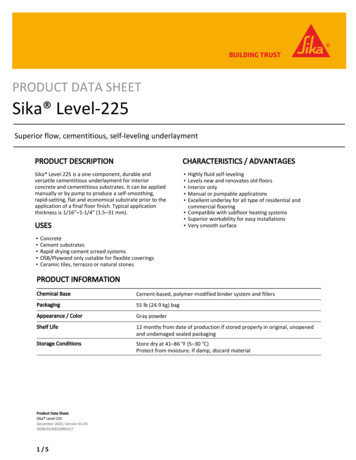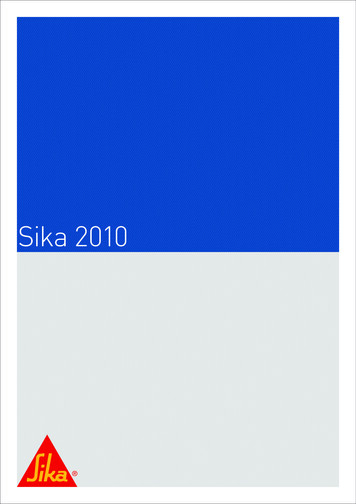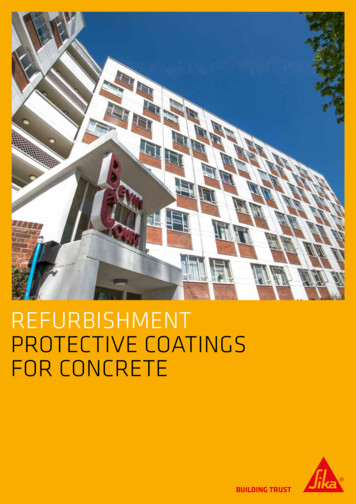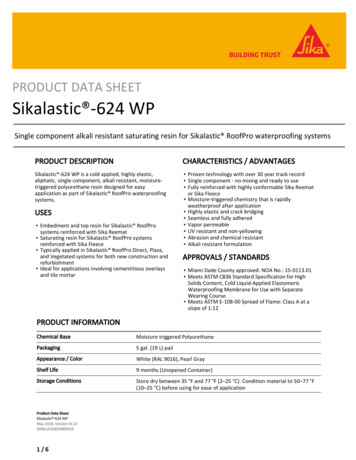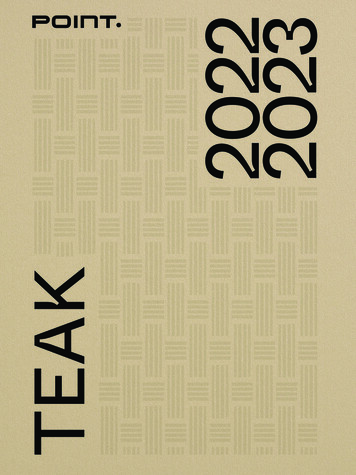
Transcription
SIKA MARINE APPLICATION GUIDETeak DeckingSIKA MARINE APPLICATION GUIDETEAK DECKINGVersion 2/2017Version 2/2017SIKA SERVICES AG1
SIKA MARINE APPLICATION GUIDETeak DeckingCONTENT03General Description04Types of Teak Deck04Joint Dimensioning06Procedure of Levelling, Bonding and Caulking of Teak Decks11Prefabricated Teak Decks14Maintenance of Teak Decks15Teak Deck Repair20Alternatives to Teak23Bonding of Timber ElementsVersion 2/2017SIKA SERVICES AG2
SIKA MARINE APPLICATION GUIDETeak DeckingDECK COVERINGSGENERAL DESCRIPTIONDeck coverings are of functional andesthetical importance. Since maritimeconditions are harsh, the ship has to beproduced not only with the best productsbut also in accordance with a professional workmanship.This manual will help to produce durablebonding and sealing solutions. For projectrelated informations we recommend toconsult the corresponding nationalTechnical Service.TEAK DECK HISTORYTeak has been used for hundreds of yearsas a durable deck material.Version 2/2017The hard wood is very durable. Naturalantimicrobial and insecticide substancescause an excellent natural anti-rot andweathering resistance.Alternatives for teak such as iroko, padouketc. are used in some cases but needs anintensive protection work to assure along time function. Usually they are usedin workboats as thick protective floors.Regardless of the type of wood used, allrequire sealants to protect the deck fromwater penetration that can cause severedamage. This can take the form ofunsightly marks along the hull, rottingthe woodwork and corroding metalcomponents.Watertight seals are therefore absolutelyessential. Also, in addition to adding structural strength to the subdeck, a woodendeck contributes to the insulation in hotand cool climates alike.Teak, however, is not a uniform material.Oil, fat, talc and resin-content, as well asporosity and colouration, differ depending on the source and age of the wood.The following pages detail the correctprocedures for the planning, laying,preparing and caulking of teak deckswith Sika’s Totally Glued Teak DeckingSystem.SIKA SERVICES AG3
SIKA MARINE APPLICATION GUIDETeak DeckingTYPES OF TEAK DECKJOINT DIMENSIONINGThe Teak planks vary in dimension. Thelater have been used for luxury vesseldecking’s with mechanical fixation. Up tonow the 22 mm planks applied with theSikaflex bonding technology result inthe same durability at a more economicprice.The joint width depends on the width ofthe plank, the humidity of the woodwhen manufactured and the expectedhumidity in use of the ship.IMPORTANT:The change of wood humidity isunder normal conditions (woodhumidity max. 12 %) in the rangeof 5 % to 6 %.GENERAL RECOMANDATION FOR JOINT WIDTH (TEAK)The joint for caulking is realised in twoways: Wood humidity 5%6%Joint width too small1. SYMETRIC OR ASYMETRIC JOINTSAdvantages: Simple manufacturing processPlank width [mm]100Disadvantages: Limited joint depth for restoration orrefurbishment grindings Higher risk of water penetrationbetween planks and the deck(detachment due to wood swelling)Recomendedjoint width500IMPORTANT:A bond breaker tape on thebottom of the joint to prevent3-side adhesion is not necessary.051015 Joint width [mm]Parameter: wood shrinkage: 0.2% / % wood humidity (teak)The humidity of the wood can be measured or estimated from the following graph:SymetricWOOD HUMIDITY (% BY WEIGHT)2. DEEP JOINT METHODAdvantages: High grinding (removal) reserve Cost saving by using thinner woodplanks Better adsorption of wood expansionDisadvantages: More complicated working procedurefor curved planksIMPORTANT:We generally recommend to usethe deep joint method wheneverpossible.Deep jointVersion 2/2017Relative humidityAsymetricTemperature10 15 20 25 30 35 40 90 %85 %80 %75 %70 %65 %60 %55 %50 %45 %40 %35 %30 %25 e: R. Kaylwert und Angaben des U.S. Forest Products Laboratory, Madison 1951CALCULATION EXAMPLE:Plank width: 50 mmProduction condition: wood humidity measured: 7 %Expected climatic conditions in use: 30 C / 70 % r.hCorresponding wood humidity (see table): 12.4 %Maximal change in wood humidity: 12.4 % – 7 % 5.4 %Maximal plank movement (teak) 5.4 % x 0.2 % / % wood humidity change x 50 mm 0.54 mmPractical excepted joint movement: 10 % of the joint widthCalculated joint width: 0.54 mm x 10 5.4 mm (practical 6 mm)SIKA SERVICES AG4
SIKA MARINE APPLICATION GUIDETeak DeckingIMPORTANT:The minimal joint width is inany case 4 mm. Adjacent jointsto walls and profiles should bedoubled in size.PRECONDITIONS OF TEAKBONDINGThe teak quality is essential for an optimalresult in respect of functionality andoptical aspect.Standing year rings as well as theabsence of alternating spiral growth areessential to assure a uniform plankdeformation under the different climates.Laying year rings may in addition lead toa danger of foot injuries due to scale ofwood formation.Fig. 1Left side: laying year rings are not recommended.Right side: standing year rings are best.Version 2/2017SIKA SERVICES AG5
SIKA MARINE APPLICATION GUIDETeak DeckingPROCEDURE OFLEVELLING, BONDINGAND CAULKING OF TEAKDECKSALUMINUM OR STEEL DECKSGENERAL WORKINGCONDITIONSThe preferred working conditions forapplying sealant to decking are as follows: Outside temperature 5 C to 35 C andmaximal 75 % relative humidity Avoid increasing temperature duringthe first day Avoid exposure to direct sunlight andrain Prevent exposure to the elements fora minimum of 8 hours after the laststep of the process Ensure adequate ventilation ifnecessary Avoid dirt, dust, oil, fat, grease, waterduring all processes as these cancause adhesion failureSURFACE PREPARATIONAND PRIMER APPLICATIONTimber decks are usually applied on topof a sub deck of steel, aluminum,polyester GRP or wood. Aluminum andsteel decks may be deformed by thewelding process and require a levellingprocess whereas wooden and polyesterGRP decks are normally even by nature.SA 205ZPSteel: the surface must be grindedor sand-blasted to remove rust,loose particles, flaked paint, contaminants, etc.When complete, remove all dustwith a vacuum cleanerAluminum: This surface should beslightly sweep-blasted or sandedTreat the surface with Sika Aktivator-205 using a clean, lint freerag or a paper towel. Change therag frequentlyFlash off: 10 minutes (min) to2 hours (max)Take care to avoid dust, dirt orother contaminates until the nextstep has been carried out Check the air humidity and temperature and apply the productonly if the surface temperature ishigher than indicated in table onpage 8 (Minimal substrate temperature to avoid water condensation). Respect the lower temperature limit. Surface and air temperature hasto be between 10 C and 35 C. Mix the two parts of SikaCor ZP Primer for 3 minutes, using anelectric paddle mixer. Scrape thesides and the bottom of the container and mix for another 30 seconds. Do not split pre-packedcans. Use full kits only. Always monitor the pot life (1hour at 30 C, 3 hours at 10 C). Apply SikaCor ZP Primer with ashort hair roller. SikaCor ZP Primer consumption, approx 200g / m2.Drying time before next application:10 C:5 to 14 hours20 C:3 to 14 hours30 C:2 to 14 hoursGLASS FIBRE REINFORCED PLASTICDECKS208Heavily soiled surfaces shouldbe cleaned off first with a puresolvent (Sika Remover-208) toremove the worst of the soilingLightly abrade the contact areawith a sanding padRemove the dust with a vacuumcleanerSA 205SMMTreat the substrate with Sika Aktivator-205, using a clean, lintfree rag or a paper towel. Changethe rag frequently!Flash off time: 10 minutes (min)to 2 hours (max)Apply a thin coat of Sika MultiPrimer Marine using a clean brush,a foam pad or a felt applicatorFlash off time: 30 minutes (min)to 24 hours (max)Protect the area until SikaCor ZP Primerhas hardened.If the area is contaminated, vacuumclean again and then treat thoroughlyusing Sika Aktivator-205.Fig. 2 Typical welds and weld splatter of a steel deckVersion 2/2017If drying time exceeds the maximum3 days flash of time, abrade the surfacewith a rotating sanding machine usingP36 grit and vacuum clean thoroughly.Then reapply the SikaCor ZP Primer.Fig. 3 Applying SikaCor ZP Primer with a rollerSIKA SERVICES AG6
SIKA MARINE APPLICATION GUIDETeak DeckingDECK LEVELLINGSteel and aluminum decks are usuallydeformed by the welding process. Theyneed to be levelled before applications ofthe teak panels. Levelling is carried outusing SikaTransfloor -352 SL (self levelling)or SikaTransfloor -352 ST (slight thixotropic). SikaTransfloor -352 SL should beused on even decks SikaTransfloor -352ST is more thixotropic and can be usedfor decks with a sheer of 3 degrees.SikaTransfloor -352 SL and SikaTransfloor -352 ST show excellent adhesion tothe SikaCor ZP Primer. It represents alightweight two-component polyurethanebased system that cures to a smoothand efficient sound damping layer.SikaTransfloor -352 SL orSikaTransfloor -352 STWeldJointSikaCor ZP PrimerSteel deckFig. 4 Cross-sectional detail of deck showing levellingof high spots (weld) and uneven surfaceIMPORTANT:Condensation or water dropletson the levelled deck will causeadhesion failure; always monitorthe dew point.APPLICATION TEMPERATUREThe temperature (substrate / product /air) should be between 10 C to 35 CIn case of unfavourable climatic conditions,humidity in the air may condensate on acolder surface. Therefore the substratetemperature has to be controlled andshould be equal or higher than indicatedin the following graph (see page 7).Version 2/2017THE DECK LEVELLING PROCESSStir component A and add component B of SikaTransfloor -352 SL or SikaTransfloor -352 ST.352 SLor STMechanically mix for three minutes at a medium speed.Avoid air entrapment.Fig. 5 MixingSikaTransfloor -352Immediately transfer the entire contents of the SikaTransfloor -352 (SL/ST) mixture to another container,scraping the sides and bottom. Mix the new containerfor another minute before transferring the mixture ontothe deck. Never scrape the remaining contents out of apail onto the deck as this may not be completely mixed.Instead transfer any remnants to the next pail in theprocess and mix in with a new quantity. Repeat this asmany times as requiredFig. 6 Transferring theSikaTransfloor -352(SL/ST) to anothercontainerPour the SikaTransfloor -352 (SL/ST) mixture onto thearea to be applied. Always observe the working time restrictions: 45 minutes at 10 C, 35 minutes at 20 C and25 minutes at 30 CFig. 7 Pouring theSikaTransfloor -352(SL/ST) to the floorSpread the mixed SikaTransfloor -352 (SL/ST) onto thedeck using a bar or straight edge at a thickness justexceeding the highest elevation point of the steel or aluminium deck. Do not apply at a thickness over 30 mm.If this should be necessary, the operation must be carriedout in several consecutive processes with intermediatesanding of the cured SikaTransfloor -352 (SL/ST) surface followed by vacuum cleaning. Working conditions:10 C to 35 C and 80 % r.h. max.Fig. 8 Spreading theSikaTransfloor -352(SL/ST)Drying time: The SikaTransfloor -352 (SL/ST) coatingcan be walked over after 24 hours and is ready for thenext stage in the processSIKA SERVICES AG7
SIKA MARINE APPLICATION GUIDETeak DeckingDECK BONDING AND BEDDINGApplication on levelled surface withSikaTransfloor -352 SL or SikaTransfloor -352 ST.APPLICATION ON OTHER SUBSTRATESIf levelling with SikaTransfloor -352 (SL/ST) is not required, planks should beoffered up and their positions should bemarked. When all have been marked, theplanks should be removed ready for theprimer.PrimerFor all woods: Apply a thin continuous coat of Sika Primer-290 DCor Sika MultiPrimer Marine usinga roller or spray equipmentFlash off times: 30 min to24 hoursIdeally the surface as well as the joint isprimed if the planks are embedded andthe sealing of the joint is executed in ashort time period.10 C (50 F)20 C (68 F)30 C (86 F)3h2h1hWaiting time before application ofSikaTransfloor -352 ST or SL5 h – 14 h3 h – 14 h2 h – 14 hWorking time SikaTransfloor -352ST and -352 SL45 min approx. 35 min approx. 25 min approx.Waiting time before installation oftimber decking with Sikaflex -298up to 14 daysup to 14 daysup to 14 daysWorking / waiting / drying time for SikaCore ZP Primer, SikaTransfloor -352 (SL/ST)MINIMAL SUBSTRATE TEMPERATURE TO AVOID WATER CONDENSATIONON THE SURFACE1)Air humidityAir temperatureProceed with sanding the surface ofcured SikaTransfloor -352 (SL/ST) priorto application of the bonding / beddingcompound Sikaflex -298 or Sikaflex -298 FC. In the time between the curingof the levelling compound and applyingthe bedding compound, the surface ofthe SikaTransfloor -352 (SL/ST) must bekept free of soiling from footprints, dirt,dust, grease, fat, oil and other contaminants. The sanding process should becarried out using appropriate belt-sanding equipment with an 80 grit paper andfollowed by a thorough vacuum cleaning.Application temperaturePot life SikaCore ZP Primer1 50 %50 %60 %70 %80 %90 %5 C00035710 C3368101115 C881013151620 C12121517192125 C17172022242630 C212124272931calculated by the dew point plus 3 C securitygray not allowed conditionyellow allowed conditionExample air temperature 10 C / relative humidity 60 % result: minimal surfacetemperature: 6 C : conclusion: not allowed working conditions (minimal 10 C).APPLICATION OFSikaflex -298 ANDEMBEDDING OF THE PLANKSSikaflex -298 or Sikaflex -298 FC is alow viscous, exceptionally strong flexibleone-component adhesive which is appliedwith a 4 mm comb trowel. The consumption should be around 1.2 liters (2x 600 mlsausages) per m2. The quantity has to beadjusted according to the surface texture.In any case the planks have to be embedded totally without any air pockets between substrate and planks.Fig. 11 Hand application picture comb trowel and combtrowel detailIMPORTANT:Only cover an area that will allowadequate time for a manageablequantity of deck planking to beplaced before a skin forms on theadhesive (see Product Datasheet).Hold the planks in place by mechanicalmeans such as weights / sandbags or byvacuum pressing.Fig. 9Applying Sika Primer-290 DC or Sika MultiPrimerMarine to a teak deck with a roller (hidden side)Version 2/2017Fig. 10 Carefully applying Sika Primer-290 DC or Sika MultiPrimer MarineSIKA SERVICES AG8
SIKA MARINE APPLICATION GUIDETeak DeckingThe fixation may be released after 24 hours.If a shorter waiting time is needed or incase of low temperature / humidity werecommend spraying sparingly a mist ofwater over the surface just before placingthe planks. The needed water quantity isonly about 1 gram water per square meterof Sikaflex -298.In such a case the fixation time is reducedto some hours.Fig. 12 Sikaflex -298 applied with a comb spreaderFig. 14 A teak floor being laid, showing the bedding compound and the weights to hold it in placeFig. 13 Putting down the deckingFig. 15 Vacuum pressVersion 2/2017Fig. 16 Vacuum equipmentSIKA SERVICES AG9
SIKA MARINE APPLICATION GUIDETeak DeckingDECK CAULKING WITHSikaflex -290 DC PROAPPLICATION OF Sikaflex -290 DC PRODECK CAULKING COMPOUNDAs soon as the teak planks are fixed, thecaulking may be done.PRIMING THE SUBSTRATE SEAMSPriming of the planks is an absolutelyvital step in the process of caulking withSikaflex -290 DC PRO.PrimerIf the planks are not alreadyprimed, this operation has to bedone using a brush in a smallersize than the joint widthIn order to achieve long-term adhesion of Sikaflex -290 DC PRO tothe sides of the joints, meticulouspreparation of the seams isrequired. Remove all dirt with avacuum cleaner.Apply a thin coat of Sika Primer290 DC or Sika MultiPrimer Marineto the edges of the joint seams. Itcan be applied by brush or spray inone coating operation. Applicationtemperature: 10 C to 35 CDrying time:10 C to 35 C: 30 min to 24 hoursIMPORTANT:If the caulking process is followednot later than one day after thebedding, priming can be donesimultaneous for both workingsteps (plank priming includingseams). Take care to avoid soilingof the teak before caulking hasbe done290 DCPROBefore any work commences,ensure that the temperature ofthe wood does not exceed 35 CIn addition, the ambient temperature during application should beconstant or falling and ideallywithin the range of 5 C and 35 CApply Sikaflex -290 DC PRO ensuring that air is prevented fromentering the seam by placing thetip of the nozzle against the bottom of the joint and keeping thegun at an angle of about 60 . Ifnarrow joints need to be caulked aspecially designed nozzle may berequired. Use a handgun, a pistondriven airgun or a battery operated gun. Continue to apply alongthe seam so that the joint appearsto slightly overfill behind the nozzle,but maintain a constant motionAfter applying Sikaflex -290 DCPRO but before skinning occurs,compress the excess materialonto the surface of the deck usinga slightly flexible spatula at an angle of 60 . This produces a convexappearance of the joint and fillsthe seam completely (see Fig. 19)Protect the joints from rain anddirect sunlight prior, during andafter caulking, for a period of atleast eight hours. Do not use excessmaterial from the spatula toprevent bubbles in the jointSikaflex -290 DC PRO is ready forsanding following the conditionsoutlined on the bar chart in Fig. 18Relative airhumidity25 %Air Temperature ( C)10 C20 C30 C5.5 days 4.5 days 3.5 days50 %4 days3.5 days3 days75 %4 days3 days2 daysFig. 19 Compressing Sikaflex -290 DC PRO with aspatulaDECK SANDINGFor efficient sanding results, use anindustrial sander. It is recommended tobegin with a medium paper at about80 grit, progressing up to 120 grit.Suitable sanders are belt sanders, flatplate, or elastically suspended sanders.Sanding should be carried out in line withthe seems. The waiting time betweenapplication of Sikaflex -290 DC PRO andsanding is indicated in Fig 18.FINISHINGIt is not recommended that a finish suchas a varnish be applied to the exteriorteak deck as these can contain solventsor plasticizers which can adversely affectthe cured Sikaflex -290 DC PRO or thedrying of the lacquer. Varnishes do notoften exhibit the flexible characteristicsof a caulk, and so the finish may alsoshow cracks, which could render the deckunsightly.See also chapter “MAINTENANCE OFTEAK DECKS” on page 14.Fig. 18 Safe sanding timeFig. 17 Applying Sikaflex -290 DC PROVersion 2/2017Fig. 20 Sanding the deckSIKA SERVICES AG10
SIKA MARINE APPLICATION GUIDETeak DeckingPREFABRICATEDTEAK DECKSMany shipyards appreciate the use ofprefabricated teak decks because they canbe manufactured off-site, rather than onboard where the process can block otheractivities. Prefabricated panels areefficient in their versatility to be producedin various shapes, quickly or on demand;as soon as the panel manufacturer hasobtained the dimensions of the boat deckproduction can be started, thus savingsubstantially on labour costs. The prefabricated panels are also very easy tohandle and to bond to the deck.Fig. 21 Customised teak decking made to measureFig. 22 A prefabricated teak deck is laid out inpreparation for fittingTYPES OF PREFABRICATEDTEAK DECKSIn modern boat-building wooden decorative decks are often constructed in theform of prefabricated panels bonded orbedded onto the sub deck. This method isoften favoured for time and cost savings.These kinds of panels are either made tomeasure (custom made) from a templatefitting the prescribed deck section, or arecut out of unidirectional panels. Prefabricated teak deck panelling comes eitherwith or without a backing.BACKINGS MAY BE Marine plywood in different thickness HPL (flat laminate) Fiberglass lamination with epoxy resinsPlywood or HPL backingFig. 23 Deep joint prefabricated teak decking and the strength and flexibility inherent in the adhesiveGRPWithout backingFig. 24 Typical prefabricated teak deck profilesVersion 2/2017SIKA SERVICES AG11
SIKA MARINE APPLICATION GUIDETeak DeckingBONDING OF THEPREFABRICATED ELEMENTSWITH HPL-BACKINGSRemove the dust with a vacuumcleanerPrimer208Heavily soiled surfaces should firstbe cleaned off with a pure solvent(Sika Remover-208) to removethe worst of the soilingLightly abrade the contact areawith an abrasive pad very fineRemove the dust with a vacuumcleanerPrimerPrimerPrimerApply a thin, continuous coat ofSika Primer-290 DC or Sika MultiPrimer Marine using a cleanbrush or a roller applicatorDrying times: Sika Primer-290 DCor Sika MultiPrimer Marine30 min to 24 hoursVersion 2/2017Apply a thin, continuous coat ofSika Primer-290 DC or Sika MultiPrimer Marine using a cleanbrush or a rollerWaiting time until deck bondingfor Sika Primer-290 DC or Sika MultiPrimer Marine 30 min to24 hoursTWO-COMPONENT COATING ON METALSTIMBER OR PLYWOOD BACKINGSRemove the dust with a vacuumcleanerSA 205Remove the dust with a vacuumcleanerTreat the substrate with Sika Primer-290 DC or Sika MultiPrimer Marine, using a clean brush orrollerWaiting time until deck bonding:30 minutes (min) to 24 hours (max)Abrade the contact area on the deckwith a sanding pad (80 / 100 grit)Apply a thin, continuous coat ofSika Primer-290 DC or Sika MultiPrimer Marine using a cleanbrush or a rollerWaiting time until deck bondingfor Sika Primer-290 DC or Sika MultiPrimer Marine 30 min to24 hoursWITHOUT BACKINGSSUBSTRATE PREPARATIONFIBREGLASS BACKINGSSteel: the surface must be groundor sand-blasted to remove rust,loose particles, flaked paint, contaminants, etc.When complete, remove all dustwith a vacuum cleanerAluminum: This surface should beslightly sweep-blastedThoroughly vacuum clean thesurfaceAbrade the contact area on thedeck with a sanding pad (60-80 grit)To bond or bed the prefabricated panels,use one-component polyurethaneadhesives such as Sikaflex -298 orSikaflex -298 FC.The adhesive has to act as an additionallayer in between the sub deck and thepanel in order to waterproof the overallsurface of the deck. As a prefabricatedfeature deck does not have to be drilledfor screws and bolts there is no puncturing of the layer and therefore no risk ofwater leakage which could damage thesub-deck.ALUMINUM OR STEEL DECKSSA 100Ensure that the treated metaldeck is compatible with Sikaflex -298. Test the paint with a solventlike acetone or a commercialavailable silicon remover or paintthinner. If the paint can be removed, sandblast off the paintdown to the metallic surface anduse SikaCor ZP PrimerTreat the substrate with Sika Aktivator-100, using a clean lintfree rag or paper towel. Changethe rag frequently!Waiting time until deck bonding:10 minutes (min) to 2 hours (max)ZPTreat the surface with Sika Aktivator-205 with a lint freepaper towelFlash-off: 10 minutes (min) to2 hours (max)Avoid dust or other contaminationuntil the next step has beencarried outApply a continuous coating to thesurface of SikaCor ZP Primerwithin 2 hours of the Sika Aktivator-205 treatment. Use a cleanbrush or a roller at a consumptionof approx. 200 gm / m2 or 80 µmthickness.Waiting time until deck bonding:10 C minimal 5 to 14 hours20 C minimal 3 to 14 hours30 C minimal 1 to 14 hoursAPPLICATION ANDPOSITIONING OFTHE PREFABRICATEDDECK ELEMENTSSikaflex -298 or Sikaflex -298 FC is alow viscosity, exceptionally strongflexible one-component adhesive whichis applied with a 4-5 mm comb trowel.The consumption should be around1.2 litres (2x 600 ml sausages) per m2.The quantity has to be adjusted according to the surface texture. In any casethe planks have to be embedded totallywithout any air pockets betweensubstrate and planks.Remove the air after the element waslaid down with a steel roller. Start in themiddle of the deck towards the edge ofthe element (See Fig. 11).SIKA SERVICES AG12
SIKA MARINE APPLICATION GUIDETeak DeckingBONDING PROCESS298208Apply the adhesive to the previouslyprepared surface and spread it using a spreader with 4 mm triangularnotches. The bed thickness mayvary depending on the thicknessof any gap that needs to be filledIf HPL or GRP-laminates have to bebonded, spray a light mist of wateron the Sikaflex prior to positioning the panels (about 1 g / m2).If one of the bonded partners iswood, the application of a watermist is not necessary but sometimes useful to accelerate the cureat lower temperatureThe deck panel must be positionedaccurately and pressed firmly intoplace Use a roller to eliminate airpocketsUncured Sika adhesives or sealantsshould be removed with Sika Remover-208 on non porous substrates. On porous substrates letharden the Sikaflex soiled on teakand eliminate it mechanicallyClamps, weights or screws (removable once the adhesive has set)can be used to secure the panel.Alternatively, the vacuum pressmethod can be usedAfter 24 hours the panels can carrytheir full service load and the temporary fastenings can be removedFig. 26 Application of Sikaflex -298Version 2/2017FINISHINGRemaining joints should be caulked assoon as the fixation means are removed.For horizontal joints, Sikaflex -290 DCPRO can be used. Vertical joints shouldbe caulked with Sikaflex -295 UV.IMPORTANT:If masking tapes are used, theyhave to be removed as soon aspossible before skinning of theSikaflex occures.Fig. 25 Sealing the edges after renovation with Sikaflex -295 UVFig. 27 Holding in place with weightsSIKA SERVICES AG13
SIKA MARINE APPLICATION GUIDETeak DeckingMAINTENANCE OFTEAK DECKSThe teak deck changes its color duringexposure to the sun and will weather intime to a silver patina. The resultinggreyish brown is sometimes wished. Insuch case we recommend to clean thedeck surface regularly with Sika TeakCleaner. Use a sponge or a brush andwork always it the direction of the woodgrain. In warm climates this procedureshould be carried out every day. Bleach,strong acids and aggressive chemicalsshould not be used at any time.Fig. 28 10 year old teak deckFig. 29 New teak deckTo maintain the colour and appearance ofa new teak deck, Sika offers a maintenancesystem: Sika’s Teak Maintenance Systemis fully compatible with Sikaflex -290 DCPRO caulked teak decks.Sika’s Teak Maintenance System consistsof the following:SIKA TEAK C B BIOThis remove dirt, salt residue and oilypollution, as well as algas and it brightensnatural weathered teakFig. 30 Keep decks looking like new by using the appropriate maintenance productsApply directly to either wet or dry teakusing a scrubbing brush and/or a cloth.Work always it the direction of the woodgrain. Leave for 10 minutes beforerinsing off with fresh water.Important: Work in segments to avoiddrying or too long reaction timeSIKA TEAK OIL NEUTRALApply this with a clean rag, brush or rollerto dry, cleaned wood and allow the oilto penetrate for about 30 minutes beforeremoving the excess. Reapplication isrecommended at the first signs ofweathering.Version 2/2017Fig. 31 The Sika range of teak deck maintenance productsSIKA SERVICES AG14
SIKA MARINE APPLICATION GUIDETeak DeckingTEAK DECK REPAIRDECK ANALYSIS RESPONSESMost quality timber decks are of teak.For this reason, most of the proceduresoutlined in this manual are focused onthat material.Please note that water intrusion betweenwood and deck may lead to fouling of thewood. It is recommended to control thedeck periodically and repair non tightareas before the whole deck is affectedor part of the wood detaches from thedeck due to the wood expansion withpermanent water contact.Deciding whether or not a wooden deckneeds to be repaired is not always easy.First, it must be established that a jointhas failed or that the wood has beendamaged sufficiently to cause a problem.Each and every joint should be closelyinspected. Any points at which there is asmall gap or crack in the caulk should bemarked with distinctive chalk.Similarly, the wood surface should alsobe closely examined for undue wear,gashes, splitting or splintering and shouldbe marked with chalk in a similar way.However, parts or all of damaged planksshould be replaced, according to howbadly they are damaged.One simple test is to observe the burningbehaviour of the sealant or adhesive.Wood that has become damaged by watertrapped in a failed joint becomes moreporous than the wood surrounding it. Thiscan result in the damaged wood changingcolour. It also means that it will remainwet after the rest of the deck has dried.Wetting the deck and closely examiningthe areas that remain wet after therest has dried, is an effective method foridentifying problem areas.For that a small test piece of the testproduct will be ignited with a pocketlighter.Flammable. Yellowflame with an intenseblack fume and blackashes indicates apolyurethaneFig. 32 Discolouration of the wood is a tell-tale sign of afailed or damaged joint in this teak deckSlight wooddamageWoodundamagedSerious jointdamageReplace deck withnew prefabricatedor built in-situ deckReplace all joints,then sand and restore whole deckReplace all jointsSlight joint damageReplace damagedjoint areas, replacedamaged wood areas, then sand andrestore whole deckReplace damagedjoint areas, thensand and restorewhole deckReplace damagedjoints onlyReplace damagedwood areas. Sandand restore wholedeckSand and restorewhole deckClean the deck.Restore the wood ifnecessaryWhich repair solution will be chosen depends on the state of the deck and theexpected result.Version 2/2017The type of flame, the flammability andthe smoke gives a good indication of theproduct base.Flammable. Yellowflame without blackfumes indicates a Product based on Hybridsor MS-polymersSerious wooddamageJoints undamagedIn the following part all possible repairsolutions are described. However toachieve a perfect result, the chemicalcomposition of the origi
Aktivator-205, using a clean, lint-free rag or a paper towel. Change the rag frequently! Flash off time: 10 minutes (min) to 2 hours (max) SMM Apply a thin coat of Sika Multi-Primer Marine using a clean brush, a foam pad or a felt applicator Flash off time: 30 minutes (min) to 24 hours (max) Fig. 3 Applying SikaCor ZP Primer with a roller
